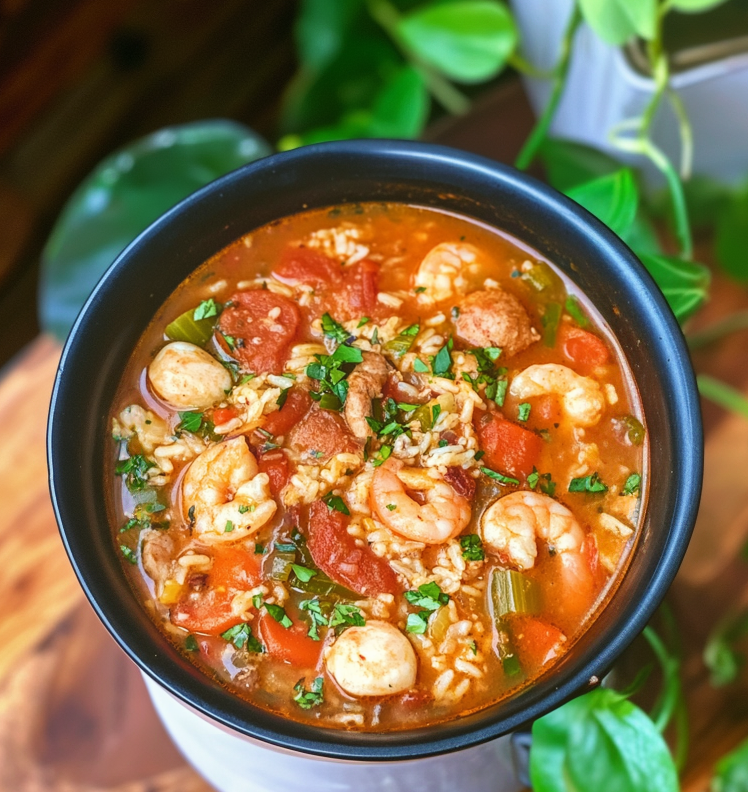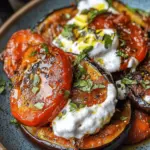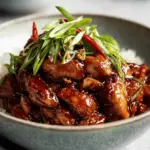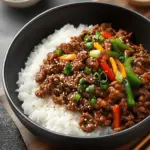Jambalaya Soup is a hearty and flavorful dish that brings the bold tastes of Louisiana to your table. Combining the rich traditions of Cajun and Creole cooking, this soup features a medley of meats, vegetables, and spices, all simmered together to create a comforting and satisfying meal. Whether you’re preparing it for a family dinner or a festive gathering, Jambalaya Soup is sure to impress with its depth of flavor and vibrant ingredients.
Full Recipe:
Ingredients
- Chicken, andouille sausage, and shrimp
- Onions, bell peppers, celery (known as the “Holy Trinity” in Cajun and Creole cuisine), jalapeño, and garlic
- Creole seasoning, red chili flakes, and bay leaves
- Canned tomatoes and chicken broth
- Rice (with an option to substitute cauliflower rice for a keto-friendly version)
Directions
- Brown the chicken and andouille sausage in a large pot to develop flavor. Remove and set aside.
- In the same pot, sauté onions, bell peppers, and celery until translucent. Add garlic and jalapeño, cooking for a few more minutes.
- Return the meats to the pot. Stir in flour and spices until well mixed.
- Add canned tomatoes and chicken broth. Simmer for 15 minutes to allow flavors to meld.
- Incorporate rice into the soup, simmering until it’s cooked through, approximately 15-20 minutes.
- Finally, add shrimp and cook until they are pink and fully cooked.
Nutritional Facts
Note: Nutritional values are approximate and can vary based on specific ingredients and portion sizes.
- Calories: Approximately 350 per serving
- Total Fat: 15g
- Saturated Fat: 5g
- Cholesterol: 120mg
- Sodium: 900mg
- Total Carbohydrates: 25g
- Dietary Fiber: 3g
- Sugars: 5g
- Protein: 30g
Historical and Cultural Significance
Jambalaya has a fascinating history that reflects the diverse cultural influences in Louisiana. It is widely believed to have been inspired by Spanish paella but adapted by the local Cajun and Creole populations to suit available ingredients and tastes. The dish embodies a true melting pot of culinary traditions, combining African, French, Spanish, and Native American influences. The term “jambalaya” itself is thought to derive from Provençal or Catalan words relating to rice dishes.
Originally, jambalaya was a communal dish prepared for large gatherings, making use of whatever meats and vegetables were on hand. This spirit of resourcefulness and community remains central to the dish’s identity today. The soup version retains the comforting and filling nature of traditional jambalaya but offers a warm, brothy consistency that is ideal for colder months or whenever a soothing, flavorful soup is desired.
Flavor Profile and Ingredients Harmony
What makes Jambalaya Soup truly special is its complex layering of flavors. The base begins with the Cajun “holy trinity” of onions, celery, and bell peppers, which lay the aromatic groundwork. This is enhanced by garlic and the smoky spiciness of andouille sausage, combined with tender pieces of chicken and succulent shrimp. The use of Creole seasoning—a blend of paprika, cayenne, thyme, oregano, and other spices—adds a distinctive punch, creating the characteristic savory, slightly spicy, and deeply flavorful profile.
The inclusion of rice in the soup provides a comforting texture that thickens the broth slightly, making it more substantial without overwhelming the delicate balance of flavors. Tomatoes add a subtle acidity and sweetness that brighten the overall taste, while jalapeños or chili flakes offer an optional heat that can be adjusted to individual preference.
Nutritional Benefits and Considerations
Jambalaya Soup is a well-rounded meal that delivers a satisfying mix of macronutrients. The lean proteins from chicken and shrimp are rich in essential amino acids needed for muscle repair and overall health. Andouille sausage contributes protein but also adds fats, including saturated fats, so moderation is key for those watching cholesterol levels.
The vegetables contribute vital vitamins, minerals, and dietary fiber, supporting digestion and immune health. Onions and bell peppers provide antioxidants like vitamin C and flavonoids, while celery offers anti-inflammatory compounds and fiber.
Rice, a staple carbohydrate in this dish, supplies energy and is a good source of B vitamins. For those managing carbohydrate intake or following low-carb diets, substituting cauliflower rice is an effective way to reduce the glycemic load while retaining texture.
Despite its many benefits, the sodium content can be relatively high due to the use of broth, sausage, and seasoning blends. Those sensitive to salt intake should consider opting for low-sodium broth and adjusting spices accordingly. The soup’s fat content can also be balanced by choosing lean chicken cuts and trimming excess fat from sausages.
Cooking Techniques and Their Impact on Flavor
The method of preparation plays a significant role in developing the deep flavors characteristic of Jambalaya Soup. Browning the meats before adding the vegetables allows the Maillard reaction—a chemical process that creates complex flavor compounds—to occur. This step imparts a rich, caramelized taste to the meat, which permeates the entire dish.
Sautéing the “holy trinity” of vegetables slowly releases their natural sweetness and aromatic oils, forming a flavorful base. Deglazing the pot with broth or tomatoes lifts the browned bits from the pan, infusing the soup with even more depth.
Simmering the soup allows the flavors to meld harmoniously. The rice absorbs the broth, swelling with the essence of spices and meat juices, which gives the soup its signature heartiness. Adding shrimp near the end of cooking ensures they remain tender and succulent, preventing overcooking.
Versatility and Variations
One of the greatest strengths of Jambalaya Soup is its versatility. It can be easily adapted to suit different dietary needs and preferences without sacrificing flavor. For example, vegetarians and vegans can swap the meat for hearty mushrooms, tofu, or plant-based sausage alternatives while maintaining the traditional vegetable and spice base.
Spice levels can be customized from mild to fiery by adjusting the amount of cayenne, jalapeño, or hot sauce used. Similarly, swapping white rice for brown rice adds more fiber and a nuttier flavor, catering to those seeking a healthier twist.
Regional variations also abound. Some cooks prefer a creamier broth with the addition of coconut milk or cream, while others might introduce different seafood varieties or smoked meats. These adaptations showcase the adaptability of the dish while keeping its authentic spirit intact.
Serving Suggestions and Complementary Dishes
Jambalaya Soup is a meal in itself but pairs beautifully with several side dishes to complete the dining experience. A crisp green salad with a tangy vinaigrette offers a refreshing contrast to the rich, spicy soup. Cornbread or garlic bread is an excellent accompaniment, perfect for soaking up the flavorful broth.
For a full Cajun-inspired feast, serving the soup alongside gumbo, étouffée, or dirty rice creates a festive meal that highlights the diversity of Louisiana cuisine. Garnishing the soup with fresh parsley or scallions adds color and a burst of freshness, enhancing both presentation and taste.
Cultural Impact and Popularity
Jambalaya Soup has transcended its origins to become a beloved dish across the United States and internationally. Its robust flavors and satisfying nature make it a go-to comfort food, especially in colder seasons. It is frequently featured in festivals, food trucks, and restaurants celebrating Cajun and Creole food traditions.
This soup not only represents a culinary tradition but also tells a story of cultural blending and community. It embodies the spirit of sharing and celebration, often prepared in large batches for gatherings, potlucks, and family dinners.
Conclusion
Jambalaya Soup is much more than just a meal—it’s a flavorful journey into the heart of Louisiana’s culinary heritage. With its bold spices, hearty ingredients, and satisfying texture, it perfectly captures the warmth and hospitality of southern cooking. Its rich history and adaptability make it an enduring favorite for both traditionalists and adventurous cooks alike.






